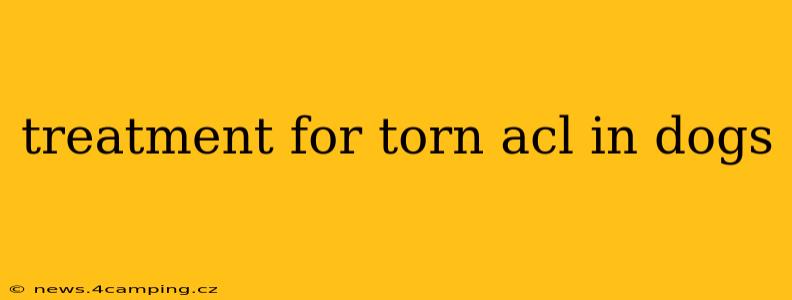A torn anterior cruciate ligament (ACL), also known as a cranial cruciate ligament (CCL) rupture, is a common and debilitating injury in dogs. This injury affects the stifle joint (knee) and can cause significant pain, lameness, and instability. Understanding the various treatment options available is crucial for ensuring your canine companion receives the best possible care. This guide explores the different approaches to treating a torn ACL in dogs, answering frequently asked questions to help you navigate this challenging situation.
What are the Symptoms of a Torn ACL in Dogs?
Symptoms of a torn ACL can vary depending on the severity of the tear and your dog's breed and size. Common signs include:
- Sudden lameness: Your dog may suddenly limp or refuse to put weight on the affected leg.
- Swelling: Noticeable swelling around the knee joint is a frequent indicator.
- Pain: Your dog may show signs of pain when the affected leg is touched or manipulated.
- Stiffness: The leg may appear stiff or have limited range of motion.
- Clicking or popping sound: You might hear a clicking or popping sound when the knee is flexed or extended.
- Muscle atrophy: Over time, the muscles in the affected leg may waste away due to disuse.
What are the Different Treatment Options for a Torn ACL in Dogs?
There are several treatment options available for a torn ACL in dogs, ranging from conservative management to surgical intervention. The best approach depends on factors such as your dog's age, breed, activity level, overall health, and the severity of the injury.
1. Conservative Management (Non-Surgical Treatment)
Conservative management involves managing pain and inflammation through rest, restricted activity, and medication. This approach may be suitable for smaller dogs, older dogs with other health concerns, or those with mild tears. It typically involves:
- Rest and confinement: Limiting activity to prevent further damage.
- Pain medication: Non-steroidal anti-inflammatory drugs (NSAIDs) can help manage pain and inflammation. Always consult your veterinarian before administering any medication to your dog.
- Physical therapy: A rehabilitation program can help strengthen the muscles surrounding the knee and improve joint stability.
- Weight management: Maintaining a healthy weight reduces stress on the joint.
2. Surgical Treatment
Surgical intervention is often necessary for larger dogs, more active dogs, or those with severe tears. Several surgical techniques are available:
- Tibial Plateau Leveling Osteotomy (TPLO): This procedure changes the angle of the tibia to stabilize the knee joint. It's considered a gold-standard approach, providing excellent long-term results.
- Tibial Tuberosity Advancement (TTA): This technique shifts the tibial tuberosity forward, stabilizing the joint and reducing stress on the ACL.
- Extracapsular Repair: This is a less invasive technique that involves placing sutures outside the joint capsule to provide support. It's generally less effective than TPLO or TTA in the long term.
What is the Recovery Time After ACL Surgery in Dogs?
The recovery time following ACL surgery varies depending on the surgical technique used, your dog's age and overall health, and adherence to post-operative care instructions. It generally involves a period of restricted activity and physical therapy. Your veterinarian will provide specific instructions for post-operative care, which may include:
- Strict confinement: Initially, your dog will need to be confined to prevent weight-bearing on the affected leg.
- Pain medication: Pain management is crucial during the recovery period.
- Physical therapy: A structured rehabilitation program is essential for strengthening muscles and regaining joint stability.
- Gradual return to activity: Your dog will need to gradually increase activity levels under your veterinarian's guidance.
How Much Does ACL Surgery for Dogs Cost?
The cost of ACL surgery in dogs can vary significantly depending on your location, the veterinary surgeon's fees, the specific surgical technique employed, and any complications that may arise. It's essential to discuss the estimated costs with your veterinarian before proceeding with surgery.
What are the Long-Term Outcomes of ACL Treatment in Dogs?
The long-term outcome of ACL treatment in dogs depends on several factors, including the treatment method chosen, the dog's overall health, and adherence to the post-operative care plan. With appropriate treatment and rehabilitation, most dogs can regain a good level of function and mobility. However, some dogs may experience some degree of residual lameness or osteoarthritis later in life.
This information is for general knowledge and does not constitute veterinary advice. Always consult with a qualified veterinarian for diagnosis and treatment of any medical condition in your dog. They can assess your dog's specific situation and recommend the most appropriate course of action.
